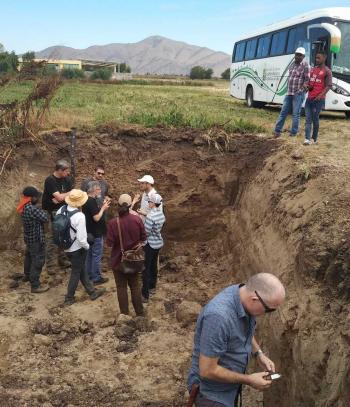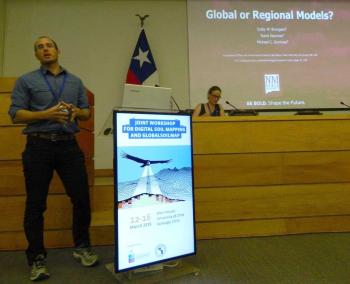Chile

NMSU Researcher Participates in International Soil Mapping Conference Dr. Colby Brungard, Assistant Professor in NMSU's Department of Plant and Environmental Sciences, participated in the Joint Workshop on Digital Soil Mapping and Global Soil Map hosted by the Universidad de Chile, in Santiago Chile 12-16 March 2019. This bi-annual workshop convenes researchers and practitioners from across the globe to present the latest research in digital soil mapping. Digital Soil Mapping is the creation of spatial databases of soil properties using an extensive combination of field observations, geospatial variables derived from digital terrain analysis and satellite remote sensing, and quantitative machine learning algorithms. Dr. Brungard presented research investigating the need for building quantitative spatial models by physiographic region rather than on a project-by-project basis. His investigations are relevant to the on-going effort to build a global soil map, which was also the focus of part of the meeting. Because of the international attendance (including Chile, Brazil, Columbia, France, Australia, the Netherlands, Denmark, Hungary, the Czech Republic, South Africa, and much of central America), Dr. Brungard was able to advertise NMSU to many international audiences and to multiple potential graduate students.
Conference participants also attended a field excursion (no soil scientist likes being inside) to the Universidad de Chile "Rinconada de Maipu" Experimental Station where they were introduced soil several soils common in the region. Surprisingly, these soils were similar to soils found in New Mexico. Dr. Brungard found it a pleasant experience to be able to explain soil development to colleagues unfamiliar with soils of dry regions, even though he was in a different hemisphere. Conference participants then enjoyed a delicious Chilean bar-b-que and learned traditional Chilean dancing from several of the Chilean graduate students.

Following the conference Dr. Brungard spent two weeks exploring the soils and landscapes of the Los Lagos and Ayusen regions of south-central Chile. During this time, he met with several members of the Chilean geological survey who were investigating a landslide/debris flow that had devastated the small community of Villa Santa Lucia. Dr. Brungard discussed soil and landscape development in areas that had been scoured by the debris flow. Dr. Brungard also had the chance to experience the remarkable rain shadow effect of the Andes when the flora of the region changed from temperate rainforest to xeric Mediterranean (similar to southern California) in the space of only 20 km!